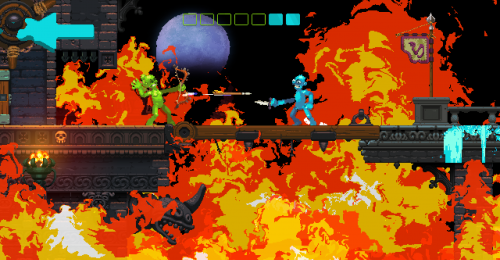Nidhogg was a perfect distillation of local competitive multiplayer games at their best. Where most of its peers focus on four-player mayhem, Nidhogg was more interested in tense one-on-one duels. But even with the lower player count, it was just as tense and thrilling — both to play and to watch — its game of tug-of-war. Every single aspect felt deliberate and extremely fine-tuned; the care that went into its design apparent at every turn.
The point is Nidhogg was already flawless. How, then, do you make a sequel? Apart from new stages, how could you iterate on something so excellent? The answer: new weapons.
Where before you could only use rapiers, in Nidhogg 2 you have access to broadswords, daggers, and bows and arrows. Your fists are also a bit more effective now as well. Each new weapon feels unique.
The broadsword can only move between high and low stances, each swing changing your stance while also almost always disarming your opponent. The dagger has limited range, but it also pushes you forward with each thrust and when thrown, travels much faster than any other weapon.
The bow has impeccable range and is devastating in the right hands, but it also leaves you open while preparing your shot and arrows can be easily reflected. With how carefully balanced the last game was, adding more weapons seems like it would upset that balance. Instead, they give Nidhogg 2 an extra ounce of strategy.
Before, you and your opponent stood on even ground at all times. You both always had the same weapon and had familiarity with its functionality. You knew how far it reached, how fast it flew it when thrown, which stances were more advantageous depending on the situation.
It ensured the game would move at its breakneck pace, allowing each player to swiftly analyze the situation and act — or react, as the case may be. But it also led each match to become predictable. There were only so many options available to you after all, and with enough time you could easily learn how to counter all them. Now, you can never count on using the same weapon. You could start with the standard rapier, but once the match gets underway, you’re swapping weapons so often that every match becomes a messy, unpredictable affair.
This, in turn, makes it much harder to maintain the lead. In all the matches I’ve played, it was always a constant struggle to make forward progress. Instead of making a beeline for the next section of the stage, jumping or rolling under each other to avoid confrontation, we had to stop and fight our way through more often.
Because we couldn’t ever count on receiving the same weapon twice in a row, blinding rushing forward would usually end with one of us being cut down, whether that was by an arrow we weren’t prepared to counter or a broadsword swing that hit us as we tried to jump over one another.
In the first game, that was often a viable strategy as long as you choose the right moment. With all these other weapons however, it forces more direct confrontations.
The level design helps accomplish this as well. While Nidhogg‘s four levels were all fantastic, the Castle stage felt like the ideal arena due to how well it used the game’s many environmental obstacles. It had wide open spaces, tight corridors, elevated platforms, pitfalls, and so on.
It was essentially the culmination of everything Nidhogg had to offer. The other three didn’t quite stack up by comparison. Nidhogg 2 avoids making that same mistake despite having far more levels (10 in total).
The key lies in how it leverages each obstacle to each level’s advantage. Each stage has its own unique hook. In Winter, you fight across slabs of ice that rise and lower based on whether both players are standing on any one slab at the same time.
In Airship, the final screen sees you fighting along the body of a nidhogg, where any weapons you drop are permanently lost. They all end up being far more involved, which in turn makes them all much more fun to fight through.
It all serves to give Nidhogg 2 a different feel from its predecessor. While it’s still very much the same game, there’s enough small tweaks that it feels just different enough to be more than just Nidhogg with a new coat of paint. From the new weapons and stages to some of the new mode modifiers like butterfingers, which randomly causes each player to drop their blades, Nidhogg 2 is a fantastic step up from the original.


